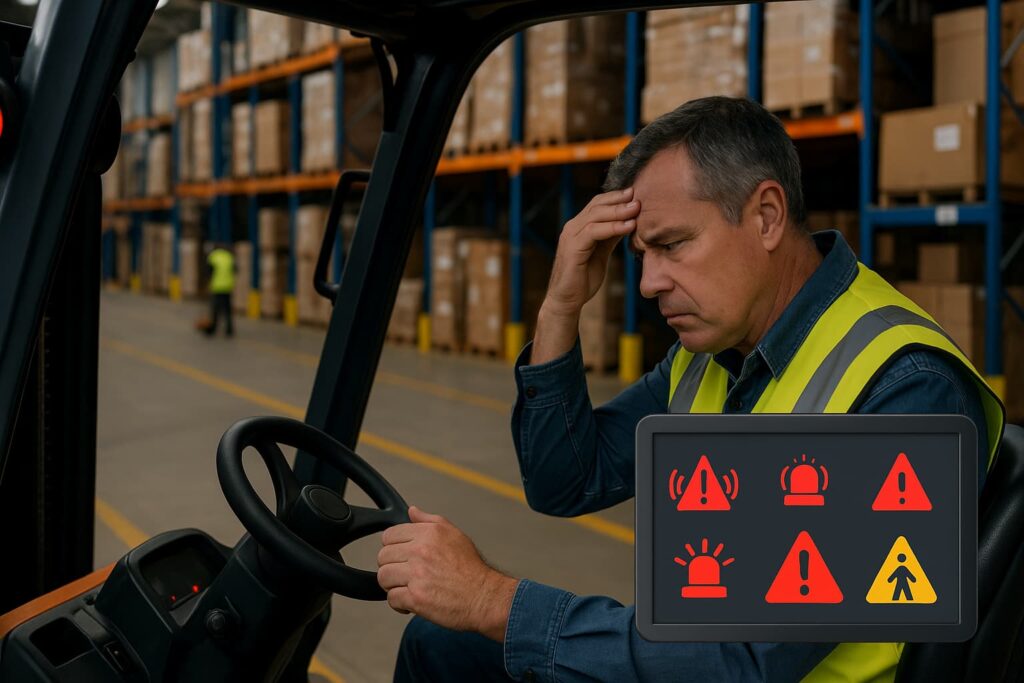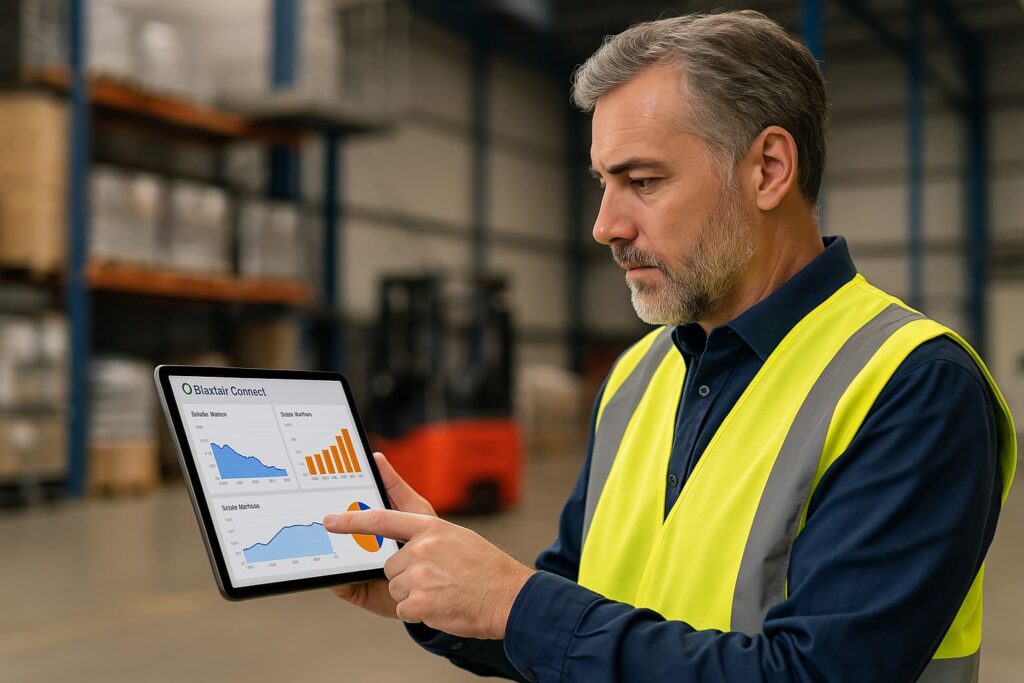Ending Alarm Fatigue with Smarter Safety Alerts
Alarm fatigue is a growing challenge in industrial environments. When safety systems issue too many false alerts, operators begin to tune them out—often with dangerous consequences. Excessive, irrelevant alarms can reduce attention, slow reactions, and create mistrust in safety technology.
Blaxtair’s AI-driven pedestrian detection system solves this issue at the source. By distinguishing people from objects in real time, it eliminates unnecessary alerts and ensures only critical warnings reach the operator. The result: fewer distractions, better focus, and safer worksites.
What is Alarm Fatigue and Why It Matters on Industrial Sites
Alarm fatigue occurs when operators are exposed to constant, non-critical alerts from their safety systems. In busy warehouses, construction zones, or mining operations, these alarms are meant to prevent accidents—but when they go off too often without a real hazard, operators start ignoring them altogether.
This desensitization leads to a paradox: the more alerts a system produces, the less effective it becomes. Over time, workers may even disable safety devices that they perceive as “always wrong,” putting everyone at greater risk.
In many cases, alarm fatigue isn’t caused by too few safety measures—but by inaccurate ones. When an AI system detects a pedestrian who is near the work area but not actually in the danger zone, it still triggers an alarm. These unnecessary alerts create noise, confusion, and frustration for operators. Accurate localization of pedestrians—knowing precisely when a person is inside the risk zone—is essential. Without this spatial accuracy, even advanced AI solutions can contribute to alarm fatigue rather than solving it.
The Real Risk of Over-Alerting: When Safety Systems Backfire
Over-alerting has consequences that go beyond frustration:
- Operator desensitization: Frequent false alarms cause operators to disregard warnings.
- Loss of trust in technology: Workers become skeptical of all safety alerts, even valid ones.
- Reduced compliance: Overwhelmed operators may mute alarms or deactivate systems entirely.
- Higher liability: Missed alerts can result in avoidable accidents and costly investigations.
Alarm fatigue isn’t just an operational nuisance—it’s a serious safety and compliance concern.

Why Traditional Systems Trigger False Alerts
Radar and Ultrasonic Sensors
While reliable for object detection, these sensors can’t distinguish between a human being and a stationary object, leading to numerous false alarms in cluttered environments.
RFID/Tag Systems
RFID-based safety solutions depend on every worker wearing a tag. When tags are forgotten, damaged, or misplaced, the system becomes ineffective—either over-triggering or failing to warn altogether.
Vision Systems Without AI
Conventional camera-based systems detect shapes or movement but lack contextual understanding. They may trigger alarms for pallets, equipment, or moving shadows, overwhelming operators with irrelevant warnings.
Some AI-based systems also struggle with spatial accuracy. They might detect a human correctly, but without precise localization, they can’t tell whether the pedestrian is actually at risk. This lack of contextual accuracy leads to repeated “false danger” alerts, causing frustration and eroding confidence in safety technology.
How Blaxtair Tackles Alarm Fatigue at the Source
Blaxtair’s AI-powered pedestrian detection goes beyond simple motion sensing. Using deep learning, it recognizes human shapes—even when partially hidden behind loads or equipment—and alerts only when an actual person is detected.
But recognition is only part of the equation. Blaxtair’s strength lies in its ability to accurately locate pedestrians within the real danger zone, ensuring that alerts are triggered only when someone is truly at risk. This precise localization minimizes false alarms and delivers the right warning at the right time.
Key benefits include:
- Fewer false alarms: Alerts are only triggered by true pedestrian presence in dangerous proximity.
- Real-time detection: Instant alerts keep response times fast.
- Customizable detection zones: Adjustable fields of view match real worksite conditions.
- Adaptability: Performs accurately indoors and outdoors, in dust, rain, or poor lighting.
With Blaxtair, operators stay focused on what matters most—real safety threats.
Operator-Centric Design: Built for Usability and Trust
Blaxtair was engineered with operator acceptance at its core. Its precise alerts minimize interruptions while maintaining immediate awareness of actual dangers.
- No wearable tags required
- Easy system integration on forklifts and heavy machinery
- Proven reliability in warehouses, quarries, and construction zones
Operators repeatedly highlight one key advantage:
“It only alerts when it should.”
That trust translates directly into safer behavior and greater compliance across the fleet.

Tech Comparison: Blaxtair vs. Tag-Based or Basic Proximity Systems
Not all safety systems are created equal. When choosing between AI vision, tag-based proximity systems, or simple ultrasonic sensors, the differences in accuracy, usability, and long-term value are significant.
Accuracy & false-alarm rates
- Tag-based or radar systems: Often produce numerous false positives because they cannot distinguish between people and inanimate obstacles.
- Basic AI without spatial precision: Detects people but struggles to assess whether they are in immediate danger, generating unnecessary alarms.
- Blaxtair: Combines human recognition with accurate localization, dramatically reducing false alerts and preventing operator fatigue.
Required user behavior
- Tag-based systems: Depend entirely on each worker remembering and maintaining a wearable tag. Missing or damaged tags create blind spots in protection.
- Blaxtair: Requires no wearable equipment. The AI automatically detects pedestrians through camera vision—no extra steps or equipment for workers.
Ongoing maintenance burden
- Traditional systems: Require frequent calibration, tag battery replacements, and ongoing manual checks.
- Blaxtair: Requires minimal maintenance, with automatic updates and alert tuning via Blaxtair Connect, ensuring consistent performance over time.
How to Validate: Run a 30-Day Pilot on Your Site
Before deploying at scale, a 30-day pilot helps you prove Blaxtair’s effectiveness in your real-world conditions. Here’s how to validate the results:
- Map field risk zones: Identify blind spots and high pedestrian traffic areas.
- Set baseline metrics: Track false alarm counts, operator feedback, and near-miss logs.
- Compare before/after outcomes: Measure changes in alert frequency and operator behavior.
- Use Blaxtair Connect for analytics: The platform provides precise data visualization and automatic alert tuning for continuous improvement.
This pilot process helps quantify impact and build operator confidence before full rollout.
Results You Can Expect
Companies adopting Blaxtair typically report measurable improvements within weeks:
- Higher operator engagement and trust in safety systems
- Reduction in unnecessary stops or alerts that disrupt workflow
- Improved near-miss visibility via Blaxtair Connect
- Less fatigue, more protection and smoother operations overall
When alerts are intelligent, everyone wins—safety managers, operators, and productivity alike.
FAQs
How does AI reduce false alarms?
Blaxtair uses AI to differentiate people from objects in real time, ensuring alerts only trigger when a pedestrian is at risk. Its spatial localization algorithms confirm where the person is, preventing alarms when they are safely outside the danger zone.
Will this work in crowded or cluttered worksites?
Yes. Blaxtair was built for high-complexity environments like warehouses, recycling plants, and construction zones. Its AI is trained on thousands of real-world scenarios to maintain reliability even in challenging conditions.
Can we test this before rollout?
Absolutely. A short pilot phase lets you validate detection accuracy, alert precision, and operator satisfaction before scaling across your fleet.
Conclusion: Alerts Mean Safer Operators
Alarm fatigue doesn’t have to be the cost of safety technology. By leveraging AI-based detection systems, companies can eliminate unnecessary alerts, improve operator focus, and prevent real accidents. The secret lies in accuracy—recognizing not just who is there, but where they are. With reliable localization, every alert counts, and every operator stays protected.
When safety systems become intelligent—and trusted—everyone benefits.
Stop Alarm Fatigue Before It Starts
Take the first step toward smarter, safer operations.
Discover how Blaxtair’s AI safety systems can help your team eliminate false alarms, improve trust, and focus on what really matters — safety.
